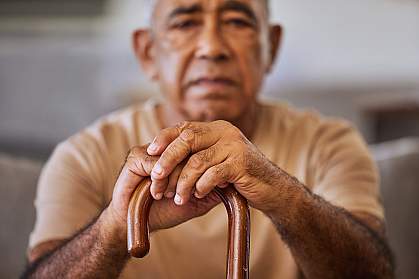You are here
April 2, 2024
Skin test detects evidence of Parkinson’s and related disorders
At a Glance
- A study showed that a simple skin biopsy could identify people who had Parkinson’s disease or similar disorders with a high degree of accuracy.
- The findings could lead to earlier, more accurate diagnosis of the neurodegenerative conditions known as synucleinopathies.

Alpha-synuclein is a protein found in brain and nerve cells. Its normal functions are poorly understood. But when an abnormal form of this protein accumulates in the brain and nervous system, it can lead to serious neurodegenerative disorders. These are collectively known as synucleinopathies. Parkinson’s disease is the most common. Others include dementia with Lewy bodies, multiple system atrophy, and pure autonomic failure.
These four disorders have some similarities. Common symptoms include tremors, cognitive changes, and progressive disability. There’s been no reliable and quantitative way to detect these conditions and measure their severity. Diagnosis often depends on assessment by specialists in movement or cognitive disorders.
A research team led by Dr. Christopher Gibbons of Beth Israel Deaconess Medical Center has been working to identify accessible biomarkers that could aid in the diagnosis of synucleinopathies. They and other scientists had previously found that abnormal forms of α-synuclein (phosphorylated, or P-SYN) could be detected in a variety of body tissues, including skin nerve fibers. They designed a study to test whether the presence of P-SYN in simple skin biopsies could identify people with synucleinopathies. The study was conducted at 30 sites that included both academic and community-based neurology practices.
More than 400 participants were enrolled in the study between February 2021 and March 2023. This included 277 people who had been diagnosed with one of the four synucleinopathies based on clinical criteria. Another 151 people with no history of neurodegenerative disease served as controls. There were near-equal numbers of males and females.
All participants underwent an expert panel review to confirm their diagnoses. They had small skin biopsies (3 mm) taken from three locations: the neck, knee, and ankle. These were then tested for the presence of P-SYN. Results were reported in the Journal of the American Medical Association on March 20, 2024.
The team found that skin biopsies could detect a high proportion of participants with synucleinopathies. P-SYN was found in 93% of those with clinically confirmed Parkinson’s disease (89 of 96 people). Biopsies were even more successful for the other conditions, identifying 98% of those with multiple system atrophy (54 of 55) and 96% of those with dementia with Lewy bodies (48 of 50). In addition, the biopsies recognized all of the 22 participants clinically diagnosed with pure autonomic failure. In contrast, P-SYN was detected in only 3% of control participants.
Levels of P-SYN in biopsies also correlated with disease severity. The skin biopsies were well tolerated and did not lead to infections or other serious complications.
“Too often, patients experience delays in diagnosis or are misdiagnosed due to the complexity of these diseases,” Gibbons says. “With a simple, minimally invasive skin biopsy test, this study demonstrated how we can more objectively identify the underlying pathology of synucleinopathies and offer better diagnostic answers and care for patients.”
Further study will be needed to validate these findings in patient populations not included in the study and explore how this approach could best be used in the clinic.
—by Vicki Contie
Related Links
- Research in Context: Diagnosing Dementia
- PET Scans of Heart May Aid Early Detection of Lewy Body Diseases
- Night Breathing Patterns Identify People with Parkinson’s Disease
- Test Distinguishes Parkinson’s Disease from Related Condition
- Tracking the Spread of Parkinson’s Proteins from Gut to Brain
- Water Changes Mark Parkinson’s Disease Progression
- Progress in Parkinson’s: Deconstructing Dopamine Degeneration
- Parkinson's Disease
- Parkinson’s Disease: Causes, Symptoms, and Treatments
- Lewy Body Dementia
- What is Lewy Body Dementia? Cause, Symptoms, and Treatments
- Multiple System Atrophy
- Pure Autonomic Failure
References: Skin Biopsy Detection of Phosphorylated α-Synuclein in Patients With Synucleinopathies. Gibbons CH, Levine T, Adler C, Bellaire B, Wang N, Stohl J, Agarwal P, Aldridge GM, Barboi A, Evidente VGH, Galasko D, Geschwind MD, Gonzalez-Duarte A, Gil R, Gudesblatt M, Isaacson SH, Kaufmann H, Khemani P, Kumar R, Lamotte G, Liu AJ, McFarland NR, Miglis M, Reynolds A, Sahagian GA, Saint-Hillaire MH, Schwartzbard JB, Singer W, Soileau MJ, Vernino S, Yerstein O, Freeman R. JAMA. 2024 Mar 20:e240792. doi: 10.1001/jama.2024.0792. Online ahead of print. PMID: 38506839.
Funding: NIH’s National Institute of Neurological Disorders and Stroke (NINDS).
